The Economics and Statistics Division maintains archives of previous publications for accountability purposes, but makes no updates to keep these documents current with the latest data revisions from Statistics Canada. As a result, information in older documents may not be accurate. Please exercise caution when referring to older documents. For the latest information and historical data, please contact the individual listed to the right.
<--- Return to Archive
For additional information relating to this article, please contact:
May 18, 2022ANALYSIS OF NOVA SCOTIA'S CONSUMER PRICE INDEX FOR APRIL 2022 TRENDS – April 2022
Nova Scotia’s All-Items Consumer Price Index (CPI) increased 7.1% year-over-year in April 2022, up from the 6.8% year-over-year increase in March. This was the highest inflation in Nova Scotia since 1991. Nationally, consumer prices were up 6.8% from a year earlier. This was also the fastest national inflation since 1991.
Impact of COVID-19 on the Consumer Price Index
In April 2022, no special treatments for goods and services due to the COVID-19 pandemic were required.
Inflation was highest in Prince Edward Island (+9.8%) while Saskatchewan (+5.9%) had the lowest. Compared to the previous month, all provinces had increases in the CPI index in April 2022 including Nova Scotia (+0.7%).
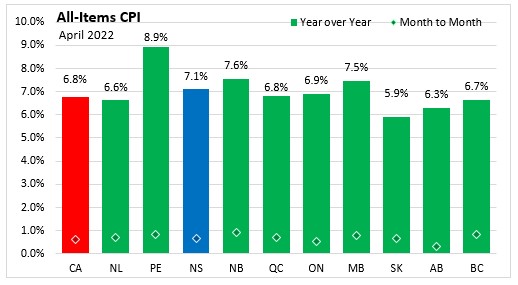
Nova Scotia’s consumer price inflation (year-over-year) excluding food and energy increased 3.4% in April 2022. Consumer prices excluding food and energy were up in all provinces led by Manitoba (5.4%). Newfoundland and Labrador had the smallest increase at 2.5%.

The CPI for food in Nova Scotia increased 9.8% year-over-year in April 2022. Nationally, food prices were also up 8.8% from a year earlier. All provinces recorded year-over-year increase in food prices led by Prince Edward Island (+10.5%). Alberta had the lowest increase at 7.7%.
Compared to the previous month, food prices in Nova Scotia were up 1.4%, above the national average of 0.9%. All provinces recorded seasonally unadjusted month-over-month gains in food prices in April.
Canadians paid 9.7% more for food purchased from stores when compared to April 2021. This was the largest year-over-year increase since September 1981 and the fifth consesutive month the increase exceeded 5.0% level. Russia's invasion of Ukraine in late February put upward price pressure on food products that use wheat while higher prices for inputs such as fertilizer and natural gas continued to increase the cost of production for farmers, who have passed some of these costs on to consumers.
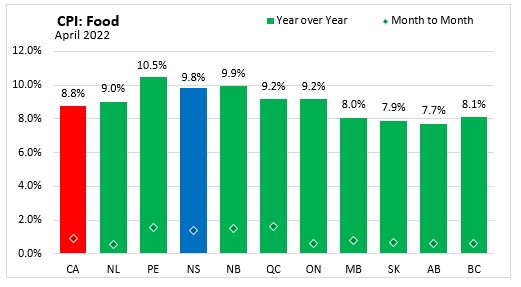
Year-over-year, shelter costs in Nova Scotia increased 7.8% in April 2022.
In April, shelter prices increased 7.4% year-over-year across Canada, the fastest pace of growth since June 1983. Higher prices for energy sources used to heat homes, such as natural gas (+22.2%) and fuel oil and other fuels (+64.4%), contributed to the increase. In Nova Scotia, fuel oil and other fules prices increased 64.7% in April when compared to the previous year.
Compared to April 2021, shelter prices were up in all provinces with the largest increase in Prince Edward Island (+14.1%) and the smallest increase in Saskatchewan (+3.7%).
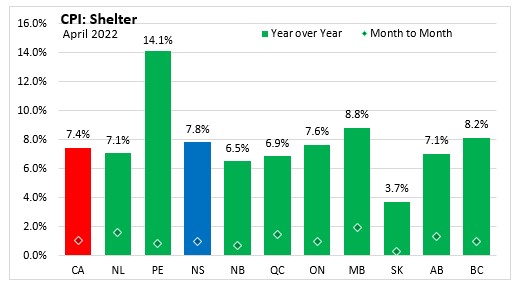
Nova Scotia's consumer price inflation (year-over-year growth in CPI) for energy was 31.2% in April, above the national average of 26.4%. Prince Edward Island (+40.5%) posted the largest year-over-year increases while British Columbia (+22.8%) had the smallest change in the energy index.
Canadian customers paid 36.3% more for gasoline in April 2022 when compared to the previous year. Nova Scotians paid 34.9% more for gasoline in April from the previous year.
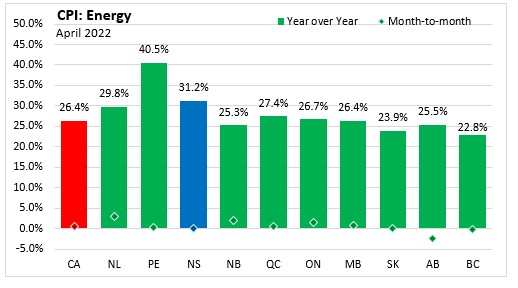
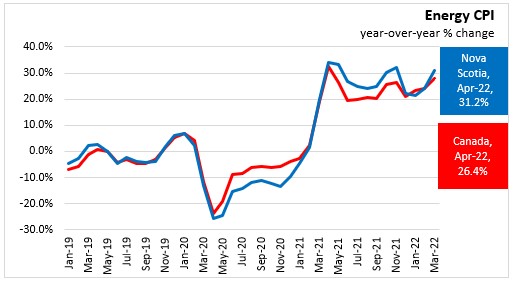
Nova Scotia's consumer price inflation (year-over-year growth in CPI) excluding energy was 4.6% in April compared to a national rate of 5.4%. Manitoba and British Columbia (both +5.8%) posted the largest year-over-year gain while Newfoundland and Labrador (+3.8%) had the smallest change in the CPI excluding energy.
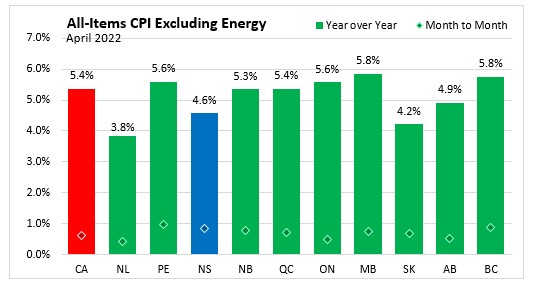
Major Components for April 2022
The following table shows the price increases specific to Nova Scotia for the major components of the CPI this month.
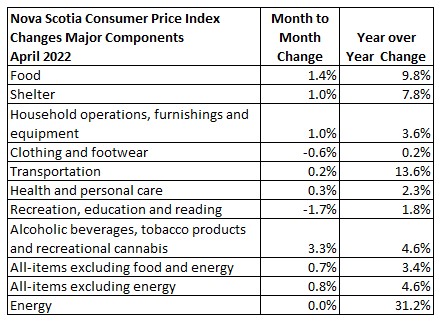
The main contributors to the monthly change (April 2022 vs March 2022) in Nova Scotia CPI were:
- Fuel oil and other fuels (+2.2%)
- Liquor purchased from stores (+7.9%)
- Beer purchased from stores (+5.2)
- Home entertaintment equipment, parts and services (-8.8%)
- Gasoline (-1.1%)
- Preserved fruit and fruit preparations (-8.7%)
The main contributors to the yearly change (April 2022 vs April2021) in Nova Scotia CPI were:
- Gasoline (+34.9%)
- Fuel oil and other fuels (+64.7%)
- Purchase and leasing of passenger vehicles (+7.2%)
- Mortgage interest cost (downward contribution, percent change not available)
- Telephone services (-7.1%)
- Video and audio subscription services (-9.0%)
Long Run Trends
In April 2022, the all-items CPI year-over-year inflation rate for Nova Scotia was 7.1%, just above the national inflation rate of 6.8%. This was hte highest inflation in Nova Scotia since 1991. Month-to-month movements in the indices can be different, but over time they generally follow the same overall trend.
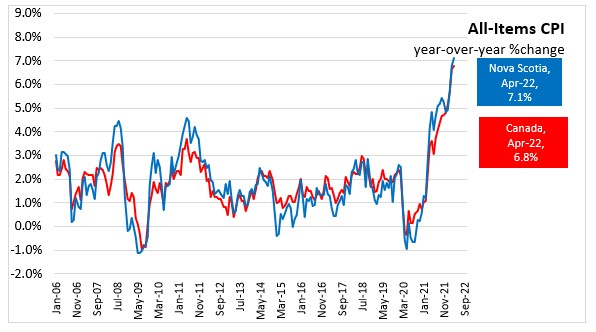
Nova Scotia’s CPI excluding food and energy increased 3.4%. Canada CPI excluding food and energy rose 4.6%. The NS CPI excluding food and energy was previously above or near 3% in 2003.

Bank of Canada's preferred measures of core inflation
Compared to April 2021, CPI-Common increased 3.2%, CPI-Median increased 4.4% and CPI-Trim was up 5.1% in Canada. All-items CPI excluding eight of the most volatile components as defined by the Bank of Canada and excluding the effect of changes in indirect taxes (formerly referred to as CPIX), rose 5.7% year-over-year. The change in the core inflation measures was up 0.2 percentage points for CPI-common, up 0.3 percentage points for CPI-Trim and up 0.4 percentage points for CPI-median from the previous 12-month period.
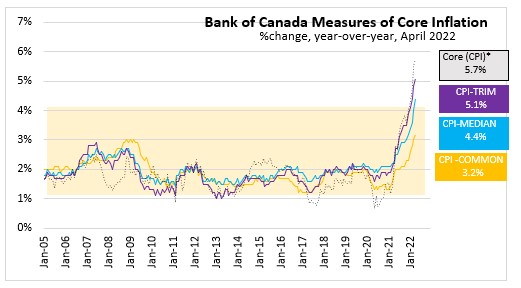
Appendix Tables and Charts
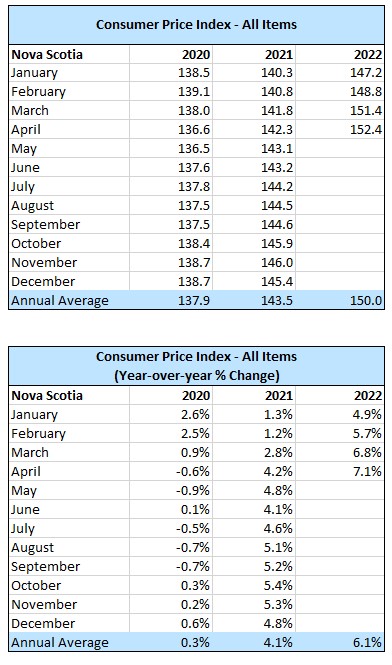
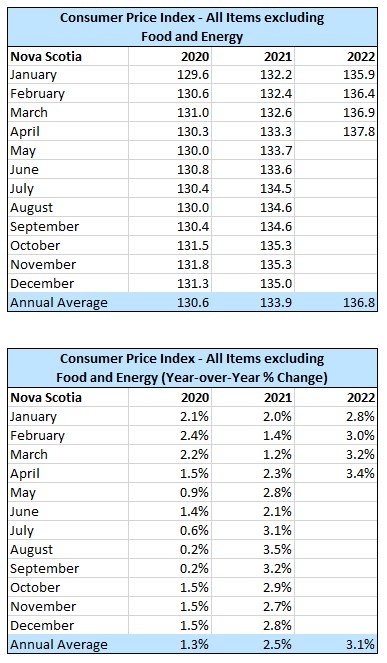
Source: Statistics Canada. Table 18-10-0004-01 Consumer Price Index, monthly, not seasonally adjusted; Table 18-10-0256-01 Consumer Price Index (CPI) statistics, measures of core inflation and other related statistics - Bank of Canada definitions
<--- Return to Archive